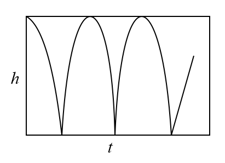Embibe Experts Solutions for Chapter: Rectilinear Motion, Exercise 2: Exercise 2
Embibe Experts Physics Solutions for Exercise - Embibe Experts Solutions for Chapter: Rectilinear Motion, Exercise 2: Exercise 2
Attempt the free practice questions on Chapter 1: Rectilinear Motion, Exercise 2: Exercise 2 with hints and solutions to strengthen your understanding. Practice Book for KVPY Aptitude Test - Stream SA Physics solutions are prepared by Experienced Embibe Experts.
Questions from Embibe Experts Solutions for Chapter: Rectilinear Motion, Exercise 2: Exercise 2 with Hints & Solutions
A parachutist with total weight drops vertically onto a sandy ground with a speed of and comes to a halt over a distance of . The average force from the ground on her is close to-
A person walks north of east for . How far would she have to walk due north and then due east to arrive at the same location?
(Take, )
A stone thrown down with a speed takes a time , to reach the ground, while another stone, thrown upwards from the same point with the same speed, takes time . The maximum height the second stone reaches from the ground is
A student performs an experiment to determine the acceleration due to gravity . The student throws a steel ball up with initial velocity and measures the height travelled by it at different times . The graph the student should plot on the graph paper to readily obtain the value of is-
A person goes from point to point covering of the distance with speed , the next of the distance at and the last of the distance at . The average speed of the person is
A ball is dropped vertically from height and is bouncing elastically on the floor (see figure). Which of the following plots best depicts the acceleration of the ball as a function of time.

A particle starts moving along a line from zero initial velocity and comes to rest after moving distance . During its motion it had a constant acceleration over of the distance, and covered the rest of the distance with constant retardation. The time taken to cover the distance is
If a ball is thrown at a velocity of in vertical upward direction, then what would be the velocity profile as a function of height? Assume .
